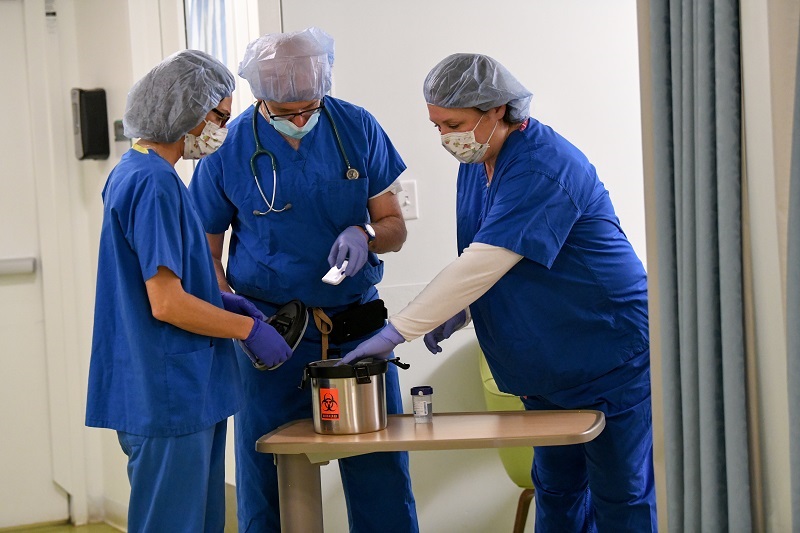Children Facing Fertility-threatening Treatments Have New Hope

June 07, 2023
Lifesaving treatments are helping children fight serious diseases and disorders like never before. Thanks to these treatments, survival rates are improving, and many children are able to live longer and achieve a high quality of life.
Still, certain treatments can lead to side effects years later, called late effects, including decreased or permanently impaired fertility in both boys and girls. Chemotherapy and radiation therapy can harm the reproductive organs and damage the tissue responsible for producing eggs or sperm, making it harder or impossible for these children to conceive later in life.
“In years past, doctors were solely focused on helping patients beat cancer and didn’t consider the late affects until after the fact,” says pediatric hematologist-oncologist Burton Eliot Appel, M.D., associate director of the Children’s Cancer Institute at the Joseph M. Sanzari Children’s Hospital at Hackensack University Medical Center. “But as survival rates for cancer and other diseases have improved, we can now emphasize reducing long-term risks, including infertility.”
Today, fertility preservation techniques, such as egg or sperm freezing, or even preserving ovarian or testicular tissue, may be an option for some pediatric patients. The fertility preservation program at Hackensack Meridian Children’s Health—the only program of its kind in New Jersey—offers plenty of heartfelt support and education, along with promising options to greatly enhance their quality of life.
What Is Involved in Fertility Preservation?
Dr. Appel, who directs the fertility preservation program at the Children’s Hospital, points out that not all chemotherapy or radiation treatment will lead to infertility. The drugs used and the total dosage are important factors in determining infertility risk.
Not all infertility loss is permanent, either. Some children and teenagers lose their fertility for a short time because of treatment, and sometimes treatment can cause complete and irreversible infertility.
At the Children’s Hospital, the program includes:
- Sperm banking for male patients
- Testicular tissue cryopreservation (freezing) for male patients of all ages, done under the auspices of a clinical trial
- Ovarian tissue cryopreservation (freezing of ovariantissue) for female patients
- Egg freezing for some post-pubertal female patients
Making Families Feel Comfortable
When children need treatments that may affect their future fertility, it’s important for parents to talk to their care team about this risk—and bring their children into the conversation when they are old enough to understand.
Presenting such a complex subject requires sensitivity, intuition and depth of experience when introducing the information either alone with the child, or with parent and child, says advanced practice nurse Rachel Heaney, APN, who works in the Children’s Hospital’s fertility preservation program.
“We make it clear that this is not the easiest conversation, discussing what happens and things that are ‘weird’ or that the child may not have discussed with an adult yet,” she says. “We explain that we’re looking to their future, and that just like a family puts money aside for the future, we’re doing something similar by planning for the future. I want parents and children to have confidence that no question is silly, and it’s important that they feel comfortable.”
The Children’s Hospital recently added the role of a fertility preservation nurse navigator to better enhance communication with families. “The addition of this position has had a major impact,” Dr. Appel says. “It means an expert can sit down with patients and families and do the detailed work that’s involved—sometimes in a very short period of time that’s not weeks or months to think about fertility preservation.”
Nurse navigator Laurie Donnelly, RN, becomes a family’s ongoing resource for information and coordination, including helping with financial assistance paperwork, as this service is often not covered by insurance. “My role is helpful when the patient and family must absorb so much confusing and complicated information so quickly while understandably experiencing stress,” Laurie says.
Instilling Optimism
Dr. Appel says the fertility preservation program can provide optimism and clarity for families who are in a challenging situation. “We want families to know that we hope and expect their child to survive this, and we want him or her to have as many opportunities as their peers,” he says.
But the team also reinforces to parents and children that the decision is their own. “We explain that we want to have the discussion about fertility preservation and what it entails, but the decision is the family’s own,” Dr. Appel says.
Next Steps & Resources:
- Meet our source: Burton Eliot Appel, M.D.
- To make an appointment with a pediatric specialist near you, call 800-822-8905 or visit our website.
The material provided through HealthU is intended to be used as general information only and should not replace the advice of your physician. Always consult your physician for individual care.






